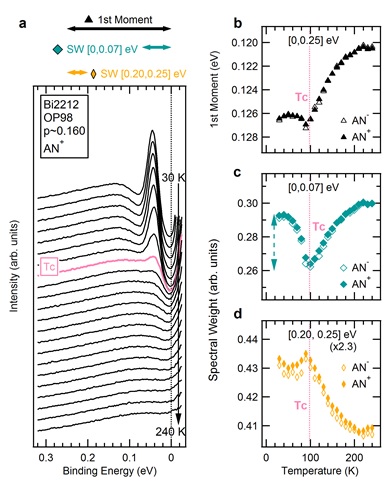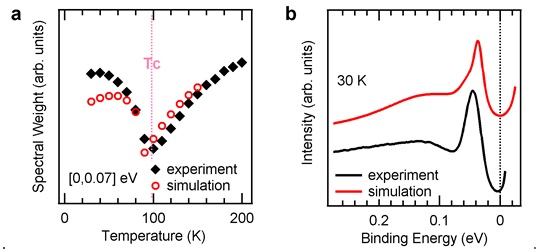
High-transition-temperature (Tc) superconductivity is one of the most intriguing emergent phenomena in strongly-correlated electron systems, where Tc can exceed the boiling temperature of liquid nitrogen. This not only implies broader possibilities for applications, but also is much higher than the putative limit of Tc ∼ 30 K for conventional superconductors described by the Bardeen–Cooper–Schrieffer (BCS) theory. In the copper oxides (cuprates) high-Tc superconductors, there exists an enigmatic normal state above Tc called the “pseudogap” state, different from conventional superconductivity in Fermi-liquid-like metals. The nature of such anomalous pseudogap state has been a main focus of the field to understand the mechanism of high-Tc superconductivity.
In a study recently published in Nature Materials, researcher Makoto Hashimoto at the Stanford Synchrotron Radiation Lightsource (SSRL), along with co-workers in the groups of Zhi-Xun Shen and Tom Devereaux at the Stanford Institute of Materials and Energy Sciences (SIMES), reported a direct spectroscopic evidence of the competition between the pseudogap and superconducting gap, utilizing the high-resolution angle-resolved photoemission spectroscopy (ARPES) experimental setup at SSRL Beam Line 5-4. They studied the hole-doped cuprate superconductor Bi2Sr2CaCu2O8+d (Bi2212), particularly focusing on the so-called antinode in the momentum space, the Fermi momentum on the Brillouin zone boundary where both the pseudogap and superconducting gap reach maximum. Beam Line 5-4 has made significant contributions to the understanding of the low-energy excitations in the cuprates for many years, which has been summarized in a recent review article on the energy gaps in high-Tc cuprate superconductors has been recently published [1].

The ARPES spectrum at the antinode shows complex lineshape and complex temperature dependence (Fig. 1a). Notably, there is no singular behavior in the spectral lineshape across Tc, which has made it difficult to disentangle the superconducting and pseudogap signatures especially around Tc. The researchers examined the spectral weight of the spectra instead of the lineshape, and were able to find clear singular behaviors at Tc in various spectral weight analyses (Fig. 1b-1d). The high stability of the beamline and endstation made it possible to detect this unforeseen striking spectroscopic signature. Such singularities in the spectral weight are well reproduced by theoretical calculations which consider the competition between the pseudogap order, modeled as fluctuating density-wave order, and superconducting order (Fig. 2a). This strongly suggests that the pseudogap is a competing order with broken translational symmetry. Further, the theoretical simulations demonstrate that it is necessary to include electron-phonon coupling in the calculation to reproduce the spectral lineshape (Fig. 2b), providing a pathway for detailed quantitative studies of the important electron-phonon coupling as possible pairing glue.

The researchers further expanded their study into the doping dependence. The spectral weight singularity becomes weaker with doping, but persists up to a high hole concentration p ~ 0.22 (black dots on the Tc dome in Fig. 3). Intriguingly, this doping level is higher than the pseudogap critical point found in the ground state at T << Tc at p ~ 0.19 (black arrow in Fig. 3) in the same experimental data. These results suggest that the pseudogap line bends back in the superconducting dome because the pseudogap order is suppressed by superconductivity. Such result provides new insights into the nature of the competitive interplay between the two intertwined orders and the complex phase diagram near the pseudogap critical point.
[1] M. Hashimoto, I. M. Vishik, R.-H. He, T. P. Devereaux and Z.-X. Shen, Energy Gaps in High-Transition-Temperature Cuprate Superconductors. Nat. Phys. 10, 483 (2014).
M. Hashimoto, E. A. Nowadnick, R.-H. He, I. M. Vishik, B. Moritz, Y. He, K. Tanaka, R. G. Moore, D. Lu, Y. Yoshida, M. Ishikado, T. Sasagawa, K. Fujita, S. Ishida, S. Uchida, H. Eisaki, Z. Hussain, T. P. Devereaux and Z.-X. Shen, "Direct Spectroscopic Evidence for Phase Competition between the Pseudogap and Superconductivity in Bi2Sr2CaCu2O8+δ", Nat. Mater. 14, 37 (2015), DOI: 10.1038/nmat4116.




